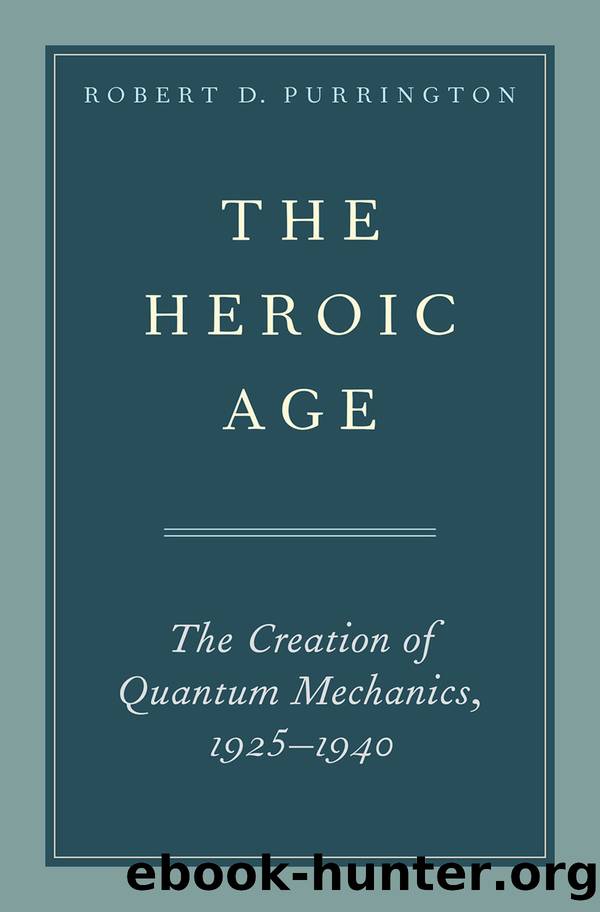The Heroic Age by Robert D. Purrington;

Author:Robert D. Purrington;
Language: eng
Format: epub
Publisher: Oxford University Press USA
Published: 2017-06-15T00:00:00+00:00
NOTES
1Dyson probably would have shared the prize but for the Nobel committeeâs restriction to three recipients. On just a small part of his contribution, that of facilitating the use of Feynman diagrams by a generation of young theorists from his position at Princetonâs Institute for Advanced Study, see the paper by Kaiser (2005). Schwingerâs Selected Papers on Quantum Electrodynamics (1958) reprints most of the important papers from that era.
2In his part I (Schrödinger, 1926a), he rather cryptically notes that if the Kepler problem is treated relativistically, it leads to half-integral radial and azimuthal quantum numbers. In part II (1926b) he has Ï satisfying the full elliptic wave equation (Eq. 18) and introduces it again in part IV (Schrödinger, 1926e, Eq. 1). Finally, in an appendix to that paper (sec. 6), Schrödinger essentially derives the Klein Gordon equation. The orbital motion of the electron in a hydrogen atom is, fortunately for Bohr and Schrödinger, nonrelativistic, because the energies are of the order of 1â10 eV, which is about 100,000 times less than the electron rest energy of 0.5 MeV. Which is not to say that there are no relativistic effects, as fine structure has a relativistic origin.
3Which might explain Schrödingerâs reluctance to give up on a wave equation with a second time derivative, as we saw in Chapter 6.
4See, for example, Schrödingerâs âequivalenceâ paper (1926c).
5Or KleinâGordonâFock; see subsequent discussion. Here we speak of Oskar Klein and Walter Gordon. Also Kudar and others. See Schweber (1994), p. 57. Wentzel (1949) called it the SchrödingerâGordon equation.
6Klein (1926a); Gordon (1926).
7Fock (1926a, 1926b).
8See, for example, Schweber et al. (1955), sec. 10, Muirhead (1965), sec. 4.3, or a variety of current sources. On the Lagrangian and principle of least action, see a mechanics text such as Goldstein (1980).
9In fact, because the pion is a composite particle (quarkâantiquark pair), there is no spinless elementary particle, except for the Higgs. The Nobel Prize in physics was awarded for its prediction in 2013, a century after the Bohr theory.
10See Schweber (1961).
11Pauli and Weisskopf (1934).
12A commutator involving Ï and a momentum variable conjugate to it. See Schweber et al. (1955).
13Dirac (1928a). The paper was published just over 2 years after Uhlenbeck and Goudsmitâs first paper. Had things gone differently, Dirac might have had the opportunity to announce, from theory, that the electron must have an intrinsic angular momentum.
14Dirac (1927b).
15Dirac (1928a). The paper was received January 2, 1928. Others, including Pauli, were not far behind.
16That is, only involving â/ât. Dirac (1928), Schweber (1994), pp. 56â8.
17Dirac (1928a). See Kragh (1990), pp. 54â5.
18Dirac developed these ideas in three papers in the Proceedings of the Royal Society: Dirac (1928a, 1928b; 1930b). He also published two papers in German in 1928 in which the theory of the electron was developed: Physik. Zeitschr.39, 561, and Leipsiger Verträge 1928: Quantentheorie und Chemie, p. 85. These are translated in his collected works (Dalitz, 1995).
19See Schweber (1961), Mandl and Shaw (1993), among many possible sources.
20Pauli (1927b); C. G. Darwin (1927).
21Dirac (1928a), p. 612.
22Dirac (1930b). It was submitted on December 6, 1929.
Download
This site does not store any files on its server. We only index and link to content provided by other sites. Please contact the content providers to delete copyright contents if any and email us, we'll remove relevant links or contents immediately.
The Complete Stick Figure Physics Tutorials by Allen Sarah(7195)
Secrets of Antigravity Propulsion: Tesla, UFOs, and Classified Aerospace Technology by Ph.D. Paul A. Laviolette(5139)
Thing Explainer by Randall Munroe(3823)
The River of Consciousness by Oliver Sacks(3457)
The Order of Time by Carlo Rovelli(3082)
How To by Randall Munroe(2943)
I Live in the Future & Here's How It Works by Nick Bilton(2869)
A Brief History of Time by Stephen Hawking(2860)
The Great Unknown by Marcus du Sautoy(2573)
What If?: Serious Scientific Answers to Absurd Hypothetical Questions by Randall Munroe(2565)
Midnight in Chernobyl by Adam Higginbotham(2409)
Blockchain: Ultimate Step By Step Guide To Understanding Blockchain Technology, Bitcoin Creation, and the future of Money (Novice to Expert) by Keizer Söze(2395)
Networks: An Introduction by Newman Mark(2286)
The Meaning of it All by Richard Feynman(2242)
Easy Electronics by Charles Platt(2233)
The Tao of Physics by Fritjof Capra(2187)
Midnight in Chernobyl: The Untold Story of the World's Greatest Nuclear Disaster by Adam Higginbotham(2102)
When by Daniel H Pink(2042)
Introducing Relativity by Bruce Bassett(2034)
